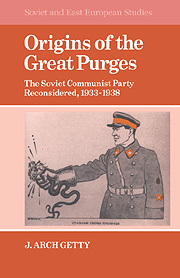Book contents
- Frontmatter
- Contents
- List of tables
- Preface
- Introduction: the Great Purges as history
- 1 The Communist Party in the thirties
- 2 What was a purge?
- 3 The Verification of Party Documents of 1935: a case study in bureaucratic ineptitude
- 4 Radicalism and party revival
- 5 Radicalism and enemies of the people
- 6 The crisis matures: 1937
- 7 Epilogue: the Ezhovshchina
- Conclusion: some observations on politics in the thirties
- Appendix: the Kirov assassination
- Bibliographic essay
- Notes
- Index
- SOVIET AND EAST EUROPEAN STUDIES
1 - The Communist Party in the thirties
Published online by Cambridge University Press: 23 September 2009
- Frontmatter
- Contents
- List of tables
- Preface
- Introduction: the Great Purges as history
- 1 The Communist Party in the thirties
- 2 What was a purge?
- 3 The Verification of Party Documents of 1935: a case study in bureaucratic ineptitude
- 4 Radicalism and party revival
- 5 Radicalism and enemies of the people
- 6 The crisis matures: 1937
- 7 Epilogue: the Ezhovshchina
- Conclusion: some observations on politics in the thirties
- Appendix: the Kirov assassination
- Bibliographic essay
- Notes
- Index
- SOVIET AND EAST EUROPEAN STUDIES
Summary
Organization is the form of mediation between theory and practice.
Georg LukácsPolitics cannot be separated mechanically from organization.
V. I. LeninReflection on the Soviet Communist Party in the 1930s has often produced the image of a closed, monolithic, disciplined organization that functioned without dissent and with a high level of centralized control. With Stalin's assumption of supreme leadership, the era of the 1920s with its freewheeling disputes on culture, its heroic personal struggles, and its debates on society and economics seemed finished. Stalin's control appears to have frozen the party into a mold of obedience rather than discussion, centrally initiated terror rather than freedom, and petrification rather than evolution.
Yet it would be naive to be taken in by Stalin's cult of personality and to accept Stalinist protestations of unity. It would be unrealistic to assume that differences of opinion in the party simply disappeared after 1929. The discussions surrounding the rate and character of industrialization, the nature of centralized decision making, the peasant question, and the parameters of political dissent certainly were muted after 1929, but they did continue.
A good deal is now known about the internal party debates on the nature and extent of collectivization that took place in 1929–31. One also knows something about the disagreements and uncertainties surrounding the treatment of “bourgeois specialists” and the changes in educational and social policy. Even later in the 1930s, writers have long suspected the existence of debates on the nature and extent of the Great Purges. Despite the efforts of the Stalinist leadership to avoid “going public” on these debates, the outlines of controversy spilled over into the press and can be studied by careful scholars.
- Type
- Chapter
- Information
- Origins of the Great PurgesThe Soviet Communist Party Reconsidered, 1933–1938, pp. 10 - 37Publisher: Cambridge University PressPrint publication year: 1985
- 1
- Cited by



